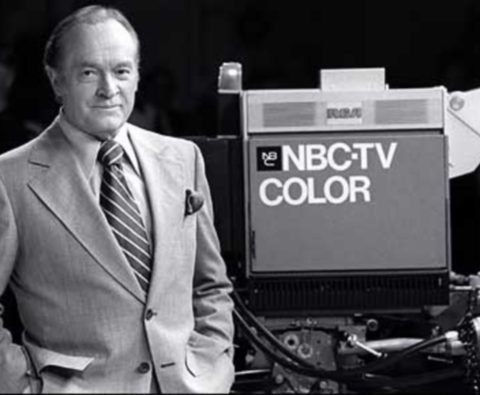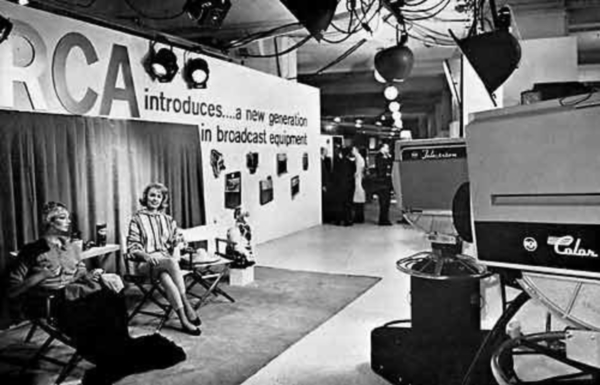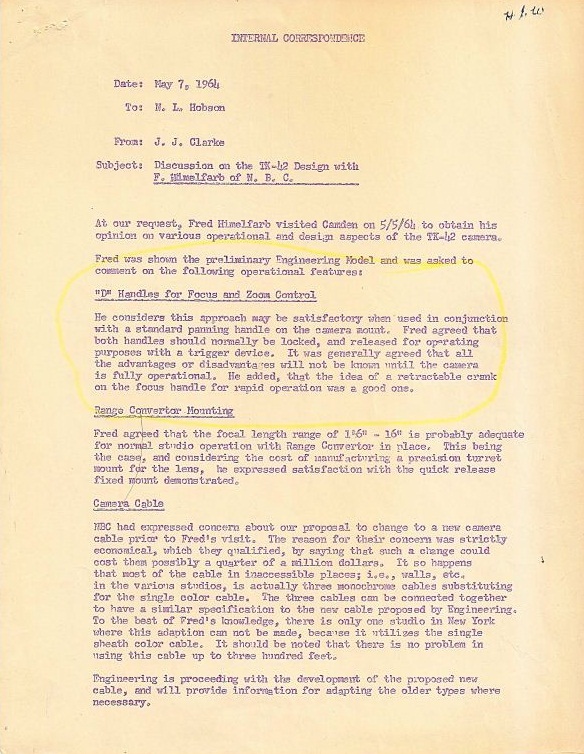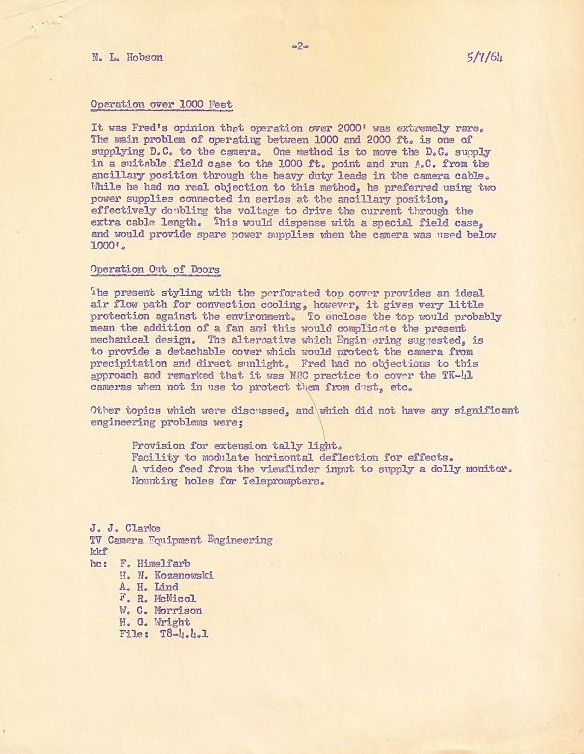

THE SECRET BACKSTORY OF THE RCA TK 44
Chapter One: by Bobby Ellerbee
Over a period of months in 2009, I spoke to former RCA engineers Lou Bazin and Larry Thorpe, and to Fred Himelfarb of NBC, about a troubled period for both companies…the 1960s. Those conversations focused on topics from how the RCA TK41 cameras continued to evolve, to what happened when the TK42-43 did not evolve. There is more on this on the RCA TK60 page, so please visit that too.
That topic led to my first hearing of the secret back-story of the TK44A development. I have written my account of these conversations below. What is now the first chapter was sent to the principals for comment and later, for ‘color commentary,’ I sent it to two eminent television historians, Lytle Hoover* (RCA) and Jay Ballard** (NBC/ABC). As you will see below, Jay and Lytle have added a whole new second chapter, and so we begin.
When RCA came out with the ‘new look’ TK12 in 1960 (which became the TK60 in ’63), they began to feel it was time to replace the TK41s with a new model; the TK42, and had an experimental model at the NAB show as early at 1962 as seen below.

In essence they wanted to put a TK41 and a TK60 in the same camera head. They wanted the TK60s 4 1/2 image orthicon, so the image broadcast to the millions of still mostly black and white receivers was sharp, but also wanted the kind of great color images that came from the TK41. With the plan to put the lens inside the TK42, that did not leave enough room for the three image orthicons and optics from the 41, so they opted for color vidicon tubes.
As a young engineer at RCA, one of Lou Bazin’s assignments was to work directly with Fred Himelfarb *** , “Pharaoh of all cameras at NBC”. Originally an RCA engineer himself, Fred had moved to NBC with the TK40s to be the master link between theory and reality. At NBC, Fred could see the cameras in their real working environments and adapt solutions to improve the 41s’ pictures and operations. He was in constant touch with Lou, and thanks to Fred, RCA made lots of hugely productive modifications to the TK41s and built in as they were made. One of the many improvements was Fred’s design of a new single camera cable to replace the 3 cable design on the early TK40s and 41s.

Above is the experimental TK42 at the 1964 NAB convention…one that is now legendary. This was the year the Norelco PC60 debuted, and the year RCA brass pulled the plug on the TK42. Literally…they turned it off and left it off. Seems that after station owners saw the plumbicon tube pictures, they were asking RCA too many hard questions about why the four-tube TK42 pictures were not that good. (On the left, the newly-renamed RCA TK60; on the right, the experimental RCA TK42).
Remember…RCA stopped making the TK41 in 1964, but NBC needed new cameras and they were not happy with the TK42. Below is an extremely rare artifact that I hope you will read. It is a two page RCA memo from May of 1964…Fred Himelfarb’s comments on the preliminary engineering model of the TK42. The intrigue continues after the memo.


It was 1965 when the TK42 got its final ‘new look’ style and 60 were shipped to local stations as none of the networks ordered any…not even NBC. The four tube design and lens ‘chatter’ were big problems for them, but more on that below. With the Norelcos out now, RCA worked to find a way for the TK42 to match the picture quality of the PC60 but were not having much luck.
With nothing on the drawing board at RCA that could equal the new PC60, the ‘sin of all sins,’ the unthinkable, was being thought by NBC management…maybe they would buy cameras not made by RCA. Finally the word came. In late ’65, Fred was instructed by management to buy 35 Norelcos for NBC’s remote trucks, but not before he worked with Norelco on custom improvements.
The RCA corporate strategy to go ‘all out’ on the TK42 was a problem at many levels, including the ego level, but this is where a great back story begins…the stealth, ‘off the books’ development of the TK44A! Yes, RCA was already thinking of the TK44, BUT, they were still thinking 4 tubes!
Under RCA Broadcast Manager Andy Ingles, Norm Hobson was the management’s link and Lead Engineer on the TK42-43. Norm suspected that soon, there would be something other than the 4 tube TK44 design needed, so he told Lou Bazin that he “found some money” in another project, and Lou got started on a 3 tube TK44A design long before everyone realized the 4 tube version would not “cut the mustard.”
Upper Management at RCA did not have any idea that plans for a 3-tube A version was in the works, but it turns out that they were glad it was happening because it saved a lot of time when word came down from the top that it was time for something new. Larry Thorpe and Lou Bazin were both fairly new RCA engineers and worked under Hobson. They were both in on the ground floor of the stealth TK44A project. Fred knew too – and remember, Fred was working with Norelco to improve the pictures for the NBC version of the PC60. RCA engineer Harry Wright was in on it too because Harry was the mechanical engineer for the 42, 43 and 44. Please visit a special section on Harry in the Archives section to see the very first sketches of all these cameras and more one of a kind images.
Now the plot thickens AGAIN! While trying to work out a 3-tube design, Lou and another RCA engineer got a very unexpected invitation from Amperex to come visit and look at the possibilities of using their tubes in RCA cameras. Amperex was a Philips subsidiary (as was Norelco) and the US source for the new Plumbicon tubes and yokes…the main component of Norelco’s ‘magic pictures’. This was a ‘no no’ as Amperex was not authorized to share this technology with RCA…but Philips was way over there in Holland and Amperex was just a short ride from Camden. There was money to be made is selling tubes to RCA. Interestingly the plumbicon tubes were made in Rhode Island at another Philips subsidiary. I have a feeling Fred Himelfarb had a hand in this unexpected invitation. After all, he was already working with Philips and Amperex for their cameras with the shorter custom plumbicons.

Above is the 1967 artist rendering of the experimental TK44, but this is not to be confused with the great TK44A that used three Plumbicon tubes. This is a 4-tube camera, using an image Isocon tube in the luminance channel, and was a camera that came out just after the 42 – just before the 44A in ’68. More on this below from Jay and Lytle.
With all this brain power studying the Norelco, it wasn’t long until the RCA TK44A 3-tube Plumbicon camera was introduced, and the first ones were sold to WBAP in Dallas and delivered in early 1968. The TK44As made better pictures than the Norelco and were much more stable.
Lou told me that to prove the stability point, Fred once sprayed Freon on one of the Norelco preamps and the picture just fell apart…registration went nuts. Then he sprayed the TK44. Although the preamp circuit board had frost all over it, the picture never even wavered.
My original draft of this story was sent for comment to all the principals and the reply from Jay and Lytle has basically added another chapter to the TK44 story.
Chapter Two: by Jay Ballard and Lytle Hoover
There is one chapter missing in the evolution of the TK-44A from the TK-42. RCA developed an interim camera between the TK-44A (plumbicon) and the 42/43-it was called the TK-44, and was a 4-tube camera, using an image Isocon tube in the luminance channel. The Isocon was used in astronomy applications and had very low noise, but could not handle the dynamic range encountered in television. The TK-44 (not 44A) was thought of as a field version of the 42/43, but still retaining the 4 tube concept.
When the TK-44 was brought outside, the picture bloomed in the intense daylight, and the story goes that Harold Seer, another RCA engineer, knew than that this design was not going to fly. The TK-44 never went into production.
Another component that made the Philips camera successful was the small prism, which RCA initially bought along with the yokes and the tubes. They were the key to the success of the PC-60/70 series. True, RCA later upgraded the TK-41 to prism optics, but the 30mm tubes made the prism much smaller than the one used for the 3″ IO.
I believe that both GE and RCA had designed lead oxide tubes, but only the Philips people were able to produce a stable target in quantities. Hats off to the Eindhoven scientists. The design was later licensed to EEV, Matsushita, and RCA with the Vistacon.
In the mid 60s, the only high-end 3-tube design was the Norelco (although Norelco experimented with a 4-tube design in Breda, per Fred van Roessel). Everyone else was 4-tube, with a luminance channel. You can see why, as there was still a large monochrome viewing audience, plus germanium transistor circuitry was prone to drift, and the 4-tube design always gave a non-derived, wide band luminance signal. It even spilled over into telecine design (TK-27, PE-240,etc).
The 42/43 sold about 500 units because the color conversion was underway and there was a desperate need for cameras and lenses. Station managements trusted RCA for its magnificent support organization, its unequaled sales force, research facility in Princeton, huge variety of products, engineering expertise; all the legends fostered by Gen. Sarnoff. But the 42/43 left RCA with a black eye, and many loyal customers turned to GE, Philips, Marconi, and others.
The Japanese were not yet a force in the world scene-yet. Station managements were also much more tolerant and trusted their chief engineers. They were making so much money in the pre-cable days-who cared if the cameras weighed 280 lbs and were noisy? Some of these stories were documented in Andy Inglis’ book Behind The Tube.
The TK-44A was a great success for RCA, and deservedly so. Almost 800 were sold, according to my customer list. Fred had a lot of input on the design. It was a big improvement over the Norelco cameras-the power supply concept, automatic cable compensation, a video operator’s dream. There were problems with cold solder joints, and grounds, but they were repairable. The TK-44-A/B spanned 20 years at NBC. Successors TK-45/46 were also popular.
Footnotes
* Lytle Hoover was a television director before becoming the manager of market research at RCA from 1968-82 and is a hugely important source of information on all things Television. His site at http://www.oldradio.com/archives/hardware/TV/RCA-TV.htm is the most comprehensive RCA history site on the world wide web.
**Jay Ballard is a world class Television historian who has recently retired from ABC NY as the engineer in charge of pre testing all the equipment the network is considering adding. Before moving there, Jay worked over twenty years at NBC’s 30 Rockefeller Plaza headquarters with NBC legend Fred Himelfarb.
***Fred Himelfarb worked at NBC from 1950 to 1990. His title when he retired was Principal Engineer of NBC Television. Unfortunately for all of us, Fred shed his mortal coil in April of 2010. Although gone, he is not forgotten.

In 1969 I started at KOGO in San Diego, They had 3 TK42’s and 3 TK43’s for the new production company. The 43’s were replaced with TK44s with serial numbers 24,25,26. They had non Plumbicon tubes in a yoke and ice cube labeled Philipp’s. These tubes were getting only a couple of hundred hours before failure. It took about 3 months before RCA supplied us with Plumbicons of their own label that made the cameras usable for the KOGO production company.